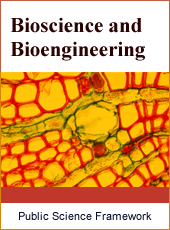Bioscience and Bioengineering
Articles Information
Bioscience and Bioengineering, Vol.1, No.5, Dec. 2015, Pub. Date: Jan. 16, 2016
Determining Break Down of Hydrocarbons in Effluent Discharges from Petroleum Service Stations
Pages: 112-117 Views: 3471 Downloads: 1338
[01]
Okova Wangaki Derek, Department of Civil and Construction Engineering, University of Nairobi, Nairobi, Kenya.
[02]
Dulo Simeon Otieno, Department of Civil and Construction Engineering, University of Nairobi, Nairobi, Kenya.
[03]
Patts M. A. Odira, Department of Civil and Construction Engineering, University of Nairobi, Nairobi, Kenya.
The study sought to find out how hydrocarbons are broken down in effluent from petrol stations by the existing bacteria in the effluent. This was established by collecting samples from two petrol station interceptors and subjecting them to chromatography tests as well as bacterial enumeration experiments over a period of forty days. It was observed that various changes took place in the samples from the chromatography results, whereby the constituent hydrocarbon quantities reduced significantly and in some cases they got eliminated completely. It was also confirmed that there existed various strains of bacteria in the samples and their population increased for a period of time until it reached an optimum where the population stagnated. Both observations realized enhanced changes and faster growth of microorganisms where nitrogen and phosphorous had been added to the samples.
Hydrocarbons (HC), Microorganisms, Effluent, Bioremediation, Degradation
[01]
April T. M., Foght J. M., & Currah R. S. (2000). Hydrocarbon degrading filamentous fungi isolated from flare pit soils in northern and western Canada. Canadian Journal of Microbiology, 46(1), 38–49.
[02]
Atlas R.M. (1985). Effects of hydrocarbons on micro-organisms and biodegradation in Arctic ecosystems. In: Engelhardt, F. R, (Ed.). Petroleum Effects in the Arctic Environment. (pp. 63–99). London, UK: Elsevier.
[03]
Brock, T. D. Madigan M. T., Martinko J. M, and Parker, J. (1994). Biology of Microorganisms. Englewood Cliffs, NJ: Prentice Hall Inc.
[04]
Chaillan F, Chaîneau C.H., Point V, Saliot A, & Oudot, X. (2006). Factors inhibiting bioremediation of soil contaminated with weathered oils and drill cuttings. J Environ Pollution 144(1), 255-265.
[05]
Choi S.C., Kwon K.K., Sohn, J.H., Kim, S.J. (2002). Evaluation of fertilizer additions to stimulate oil biodegradation in sand seashore mesocosms. Journal of Microbiology and Biotechnology, 12(3), 431–436.
[06]
Cooney, J. J. (1984). The fate of petroleum pollutants in fresh water ecosystems. In: Atlas, R.M, (Ed.). Petroleum Microbiology. (pp. 399–434). New York, USA: Macmillan.
[07]
Ferrari, M.D., Neirotti E., Albornoz, C., Mostazo M.R. & Cozzo M. (1996) Biotreatment of Hydrocarbon from Petroleum Tank Bottom Sludges in Soil Slurries. Biotechnology Letters, 18 (11), 1241-1446.
[08]
Floodgate, G. (1984). The fate of petroleum in marine ecosystems. In: Atlas, R.M. (Ed.). Petroleum Microbiology. (pp. 355–398). New York, USA: Macmillan.
[09]
Holliger, C., Gaspard, S., Glod, G., Heijman, C., Schumacher, W., Schwarzenbach, R. P. & Vazquez, F. (1997). Contaminated environments in the subsurface and bioremediation: organic contaminants. FEMS Microbiology Reviews, 20(3-4), 517–523.
[10]
Holt, J. G., Krieg, N. R., Sneath, P.H.A., Stanley. J.T. & William, S.T. (1994). Bergey's Manual of Determinative Bacteriology. Baltimore, USA: William and Wilkins.
[11]
Johnson, C.R. & Scow, K.M. (1999). Effect of nitrogen and phosphorus addition on phenanthrene biodegradation in four soils. Biodegradation. 10, 43-50.
[12]
Juhasz, A. L., Britz, M. L. & Stanley, G. A. (1996). Degradation of High Molecular Weight Polycyclic Aromatic Hydrocarbons by Pseudomanas Cepacia. Biotechnology Letters, 18(5), 577-582.
[13]
Liu, Z., Jacobson, A. M. & Luthy R. G. (1995). Biodegradation of naphthalene in aqueous nonionic surfactant systems. Applied and Environmental Microbiology, 61(1), 145–151.
[14]
MacNaughton, S.J., Stephen, J.R., Venosa, A.D., Davis, G.A., Chang, Y.J. & White D.C. (1999). Microbial population changes during bioremediation of an experimental oil spill. Appl. Environ. Microbiol.65, 3566-3574.
[15]
McMurry, J. (1988). Organic Chemistry (pp 1-122). Pacific Grove, CA: Brooks/Cole Publishing Co.
[16]
Nilanjana, D. & Preethy C. (2010). Microbial Degradation of Petroleum Hydrocarbon Contaminants: An Overview, Environmental Biotechnology Division, School of Biosciences and Technology, VIT University, Vellore, Tamil Nadu 632014, India Received 24 May 2010; Biotechnology Research International Volume 2011 (2011), Article ID 941810, 13 pages.
[17]
Olah, G. A. & Molnar, A. (1995). Hydrocarbon Chemistry (1-53). New York: John Wiley & Sons, Inc.
[18]
Organic chemistry and alkanes available at https://en.wikibooks.org/wiki last modified on 5th March 2015. Accessed the information on 20th June 2015.
[19]
Prince, R. C. (1993). Petroleum Spill Bioremediation in Marine Environments. Critical Reviews in Microbiology, 19, 217-242.
[20]
Ratledge, C. (1978). Developments in Biodegradation of Hydrocarbons. Volume 1(pp 1-46), edited by R. J. Watkinson ed. London: Applied Science Publishers LTD.
[21]
Rojas, J.G Isolation and identification of bacterial strains from a mixed wastewater treatment system used to treat petrochemical effluents. Pan American Health Organisation Tel. (777) 3-19-4000 ext. 357 Tel. y Fax (777) 3-19-4281, e-mail: jgarcia@tlaloc.imta.mx.
[22]
Tabuchi, K, Matu-ura, K, Kawakani, S., Shiratori, T. & Saitoh, T. (1998). Remediation and recycling of the soil contaminated with petroleum hydrocarbon. Metallurgical Review of MMIJ, 15(1), 14-25.

ISSN Print: 2381-7690
ISSN Online: 2381-7704
Current Issue:
Vol. 6, Issue 3, September Submit a Manuscript Join Editorial Board Join Reviewer Team
ISSN Online: 2381-7704
Current Issue:
Vol. 6, Issue 3, September Submit a Manuscript Join Editorial Board Join Reviewer Team
| About This Journal |
| All Issues |
| Open Access |
| Indexing |
| Payment Information |
| Author Guidelines |
| Review Process |
| Publication Ethics |
| Editorial Board |
| Peer Reviewers |


